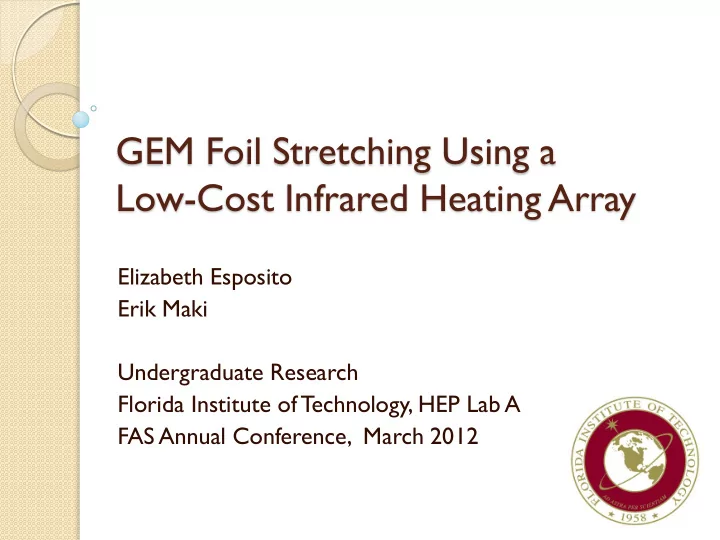

GEM Foil Stretching Using a Low-Cost Infrared Heating Array Elizabeth Esposito Erik Maki Undergraduate Research Florida Institute of T echnology, HEP Lab A FAS Annual Conference, March 2012
Overview Purpose / Background Previous work Improvements to previous work Results Conclusions Future plans
Purpose Design a cost-effective, readily- implemented method of stretching GEM (gas electron multiplier) foils, improving upon previous designs. 100cm x 50cm GEM foils stretched with this method will be used to upgrade the muon tomography station of Florida Institute of Technology’s High Energy Physics Lab A.
Why Stretch GEM Foils? GEM foils are a crucial component of detectors such as the triple GEM detector on the left. In order to be useable, they must be uniform. This uniformity is obtained through stretching, usually in a clean room oven.
Muon Tomography Station (MTS) Below: Imaging area seen with two blocks of high-Z material. • T wo 30cm x 30cm GEM detectors were built for Florida T ech’s muon tomography station using the following method. [GEM Detectors]
Previous Work • Designed to stretch 100cm x 50cm GEM foils – scaled-up from 30cm x 30cm design – as cost-efficiently as possible using locally-sourced materials. Aluminum frame supports • eight/sixteen 250W infrared heat lamps. • Used to stretch foils at 45°C - 50°C.
Why 35°C? The above GEM foil was stretched at 50°C. Note the ridging of the spacer ribs! Lower temperatures minimize / eliminate this! (CERN stretches at 37°C).
Current Design • 1” -diameter aluminum rods support the frame – allows for greater versatility and mobility. Several stations can easily be set up on the same optical table. • Sixteen 125W heat lamps were used in place of the previous 250W bulbs. • Used to stretch foils Credit: Elizabeth Esposito, 2011 at 35°C.
Results Number of temperature measurements per bin Mean: 35.12°C RMS: 0.1669
Number of temperature measurements per bin T op: Current results, 125 W bulbs RMS: 0.1669 Number of temperature measurements per bin Bottom: Previous results, 250 W bulbs RMS: 1.367
Results [Location key] Optical Table Long-T erm T emperature Variation Stable plateau reached at ~3 hours
T op: Unstretched 100 x 50cm ……. GEM foil at ~25°C. Bottom: Stretched 100 x 50 cm GEM foil at 35°C. Note the reflection of the light bulbs in the foil!
Conclusions 125 W light bulbs provided a very uniform temperature of ~35°C. Temperature variations were minimal and did not affect the operation of the array. Current results: RMS: 0.1669 compared w/ previous results: RMS:1.367. Foils stretched using this method appeared to be uniformly stretched.
Future Plans Improve the methods of temperature control. Build multiple arrays for more efficient detector construction. Use the array to stretch 100cm x 50cm GEM foils for use in upgrading Florida Institute of Technology’s muon tomography station.
Acknowledgements Research advisor: Dr. Marcus Hohlmann Previous work: Michael Staib Bryant Benson Kondo Gnanvo
Recommend
More recommend